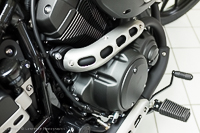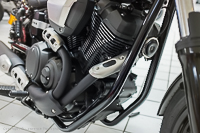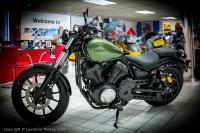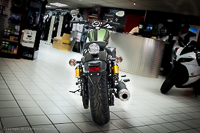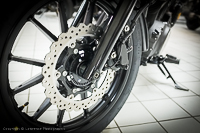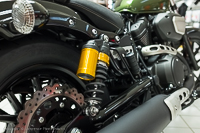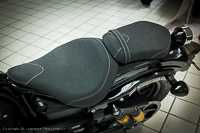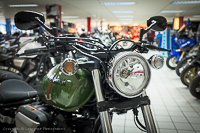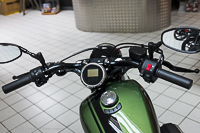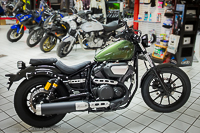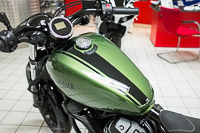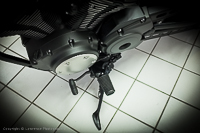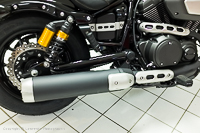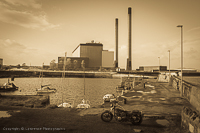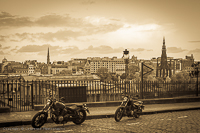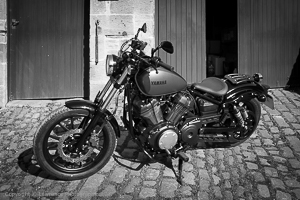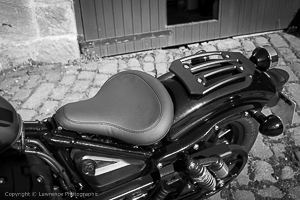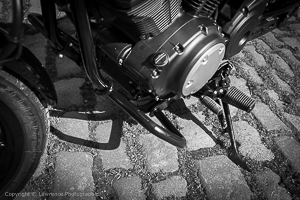From
Wikipedia - "The bobber was the earliest simple and stripped
down variety of custom motorcycle. They are hand-built by
individuals with mechanical skills, and were often part of
the early biker clubs before there were any such thing as choppers.
This style of custom
motorcycle, which took shape in the 1940s and 50s, is
generally thought to have been started by returning WWII
American servicemen working on ex-military motorcycles. They
were inspired by lighter European motorcycles they had seen
and ridden. When bobbers were first
created, the intent was not to create a new type of
motorcycle or sub-genre, the idea was to keep motorcycles on
the road as cheaply as possible. The bikes
reflected their owners and were often homemade.
Today there are many
companies that create such vehicles. The style has also
influenced motorcycle manufacturers, such as
Harley-Davidson (and now Yamaha). The bobber continues to be
favoured by some to this day. Hybrid styles have emerged,
such as the bobber chopper and retro-bobber.
Though only a bobber in name, newer bobbers are more about
independence and customization than simply being constructed
cheaply".
This ongoing review started
when I decided that I wanted a motorcycle that would be a totally
different riding experience to my sports/tourer Suzuki GSX-1250FA.
I had completed my motorcycle training in and around Edinburgh on a
650cc 'naked' motorbike with a V twin engine and I liked the vibration
of the bike when I rode it, so a V twin seemed like the ideal route to
explore.
I wanted this second bike
for 'urban' use -
travelling around the city and for those short trips in the country. I
enjoy
street photography,
so this bike had to be easy to handle in city traffic and to park.
The obvious choice was a Harley-Davidson style (lighter weight)
cruiser with a V twin engine, low seat, low centre of gravity and with
some vibration and low down torque grunt -
then the
Yamaha XV950R
caught my eye.
My Yamaha
XV950R Motorcycle - Purchase Order
I was so taken by the Yamaha XV950R motorcycle that after my research
which is outlined in this article and after completing a test ride, I
placed an order for one (11th March 2015) with
Saltire Motorcyles in Edinburgh
and will take
delivery in early April 2015.
_______________________________________________
Yamaha XV950R Motorcycle Article Contents Index -
-
Checking out the Yamaha XV950R at the Dealer and Initial Thoughts
-
It's not a Harley-Davidson 883 Iron (YouTube Videos and Specifications)
-
Healtech-Electronic Glpro-X Type Gear Indicator (Not suitable for ABS R Spec Model)
-
Seat Comfort Options (with YouTube Videos and Remarks)
-
Engine Crash Protection Bars and Link to Extensive Accessories List
_______________________________________________
The Yamaha XV950/XV950R Owner Manual is worth reading. You have to hand it to the Japanese, their owner manuals are fantastic. They are logically laid out and the maintenance section is par excellence.
The 2014 Yamaha XV950R 'Bobber' with ABS, Stitched Seat and Adjustable Shocks
_______________________________________________
Yamaha
XV950R Motor Cycle Introduction Videos
_______________________________________________
_______________________________________________
Yamaha have struck the right balance with the XV950R and I like the
wider stance, especially from the rear and there is no doubt the bike
exudes presence.
I did the usual and checked the internet, visited the bike shops and
established that there were numerous motorbikes that were specifically
designed for city 'urban' use. However, I wanted to make a statement, I
wanted a bike that was 'cool' because an older guy like me, honed during
the 60s and in the time of Steve McQueen, likes to look cool even on a
motorbike. I decided on a 'Bobber' which fitted in with my
lifestyle, a 'RAW' motorbike that looked like it
had been put together in a garage. However, I was not going to jump fences
with it like Steve
in the film 'The Great Escape'.
I
visited
Saltire Motorcyles
to take some pictures of the bike with my
Fujifilm X100s
compact camera. I loved the minimalistic look of the
Yamaha XV950R and with lines like
that why would I want to add components or customise it anymore? However
for those bikers who want to customise it, Yamaha are offering a
catalogue of bolt on parts.
The 'post war rawness' in a 'Bobber' is hard to find these days, but
Yamaha
have hit the ground running with their XV950 and especially the
XV950R with uprated suspension, ABS brakes and a stitched suede saddle.
The XV950/XV950R have those alloy 'heat protectors' mounted over the
exhaust pipe where your right leg and boot are placed when riding the
bike. That is so cool, they look like they were garage built, an after
thought, an add on after someone burnt their leg or foot on the exhaust
pipe. The exhaust is black and again just like someone grabbed a tin of
matt black paint and painted over the bare metal. Check out the horn
which is mounted between the bare front bars of the frame, fully visible and painted black, brilliant! These
are small examples of what makes the Yamaha a special 'Bobber', there
are no frills and yet the technology is bang up to date.
The round
bezel style gauge display is one area
where perhaps Yamaha have got it wrong?
It provides a digital
readout of
the speed but it would have been better in
a retro style with an ordinary digitally driven
analogue
display
and more in keeping with a post war
Joking aside, I already have the urban gear to wear with the Yamaha
XV950R bike.
The pre-requisite black helmet, black leather jacket, black jeans, boots,
gloves and even the base layer top, tribal neck scarves and you can see
them in my 'It's
a Lifestyle Thing' article. You can also see some of the clothes in the
picture below - the image is staged for effect as I don't smoke.
I have sat on the bike, started it up and felt the power of the engine
and it's exhaust note sounds throaty and loud.
I have watched the
videos and I just know that this motorbike will be very interactive. It
will be more interactive than any ordinary bike, I am going to feel it
under me, it's not going to be clinical, it's going to snarl and vibrate
slightly when I open up that throttle and it's immense torque at low
revs is going to propel me forward as heads turn when that engine
growls. There are urban motorbikes that are well just bikes - they are
like all the other bikes - then there is this 'Urban Bobber' which is so
different.
 'Bobber' style bike.
However, I could easily live with it and lets face it, the minimalistic
approach is still maintained.
'Bobber' style bike.
However, I could easily live with it and lets face it, the minimalistic
approach is still maintained.
The
display will light up the right or left direction of the indicator
(click on image to enlarge) but there is no
audible warning. However,
an indicator beeper could be fitted (somewhere discreet) in
amongst the wiring, an audible reminder to switch of the indicator when
the turn is complete. Likewise, a very discreet gear electronic indicator
with
BLUE
or
RED
numerical illumination could be fitted to the bike without taking the
eye away from it's minimalistic looks.
3rd April 2015 -
In the Yamaha Dealer's workshop, it was established that the
Glpro - X Type
gear indicator I sourced was designed for the non ABS Yamaha XV950
(USA Bolt Variant) and cannot be fitted to the UK R Spec model due
to the ABS system which would involve cutting into the wiring loom and
invalidating the Yamaha Warranty. I have still to source a compatible
gear indicator for the XV950R model?
There is no tachometer readout but again this is not a huge deal as the
bike is intended more for the 'urban biker' travelling around in the
city where you are hardly going to be thrashing the revs and keeping an
eye on a tachometer gauge. It's the same on the countryside trips, the
bike is designed for optimum torque at 3,000 rpm so I am sure the bike
will demand a gear change to maintain the acceleration momentum long
before it hits peak revs.
The
2014 XV950R model comes with green or grey coloured petrol tanks
and
the rest of the bike is painted in a standard black and matt black
finish. The standard XV950 model comes with a white or black tank.
If those colours do not suit, most third party paint shops will repaint
the tank in a custom colour to suit the individual taste.
This for me has to be the ultimate 'sports heritage' urban bike and
ideal for trips into the city and yet more than capable of longer runs.
Soon, I will get the chance
to ride one and for my test run,
I am planning to dress up for the day, a bit like a dispatch rider from
the war period to match the style of the bike - image captured at
Edinburgh Castle using a
Sony Alpha
A57 SLT Camera
(click to open larger version)
-
A bike that is interactive and alive is different - take dogs, I
like them, they come up to you and you pat them on the head, they lick
your hand and like most dogs they behave as you would expect them to
BUT then there are some that are more interactive - they stand out
from the crowd, you will never forget them. I was on holiday in Cyprus
back in 2002 and along with my girlfriend Carol we went up to the Adonis
Falls and stood in the queue to get in. I was somewhere down the line
when this huge mutt of a dog walked out of the building and decided to
pick me out. He walked up to me, stood beside me and then put his huge
mouth around my left hand whereby all that was showing were the fingers
and the wrist. I found it amusing and as I let him hold my hand, I
looked down at him and he looked up and gradually squeezed my hand with
his mouth as if seeking a reaction. I smiled at him and looked forward
whereupon he let go of the hand and walked back into the building - now
that's interaction - intense, rewarding and certainly never to be
forgotten.
The competition for the Yamaha XV950R has to be the Harley 883 Iron which as seen in the following images, has a rear wheel belt drive similar to the XV950 and the XV950R.
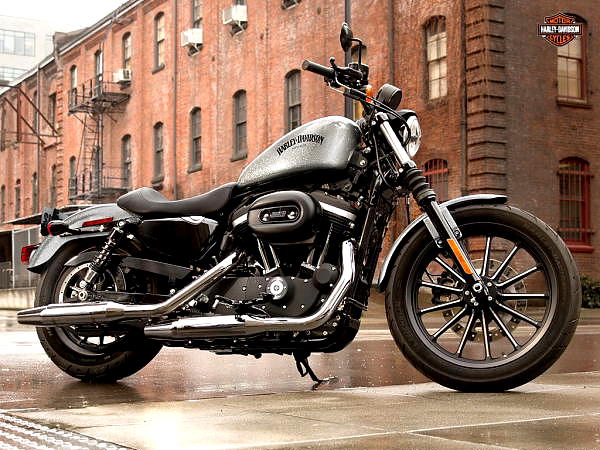
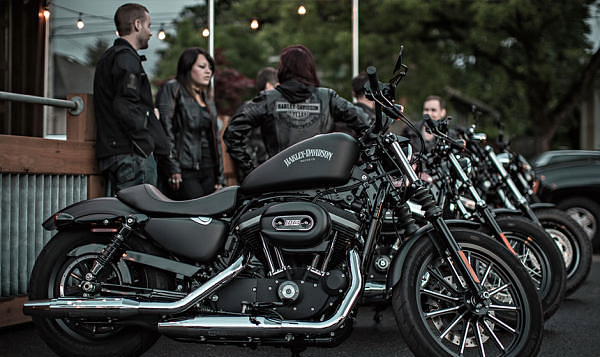
I checked out the Harley-Davidson 883 Iron which is also a copy of a 'Post War
Bobber' but it seemed from it's
appearance that it had strayed away from the original concept
of a garage build. The Harley appeared more refined and filled out, it
was not as minimalistic as the Yamaha.
According to the following video, the Yamaha XV950 which is the model
without ABS and without the uprated suspension is apparently more comfortable on the road
than the Harley 883 Iron, it has more power, especially the torque
and looks so mean that it could have been forged in the depths of hell,
albeit it has to have a black tank because the white one in the video does not cut it.
However the green tank on the XV950R is growing on me and I could see where it would
fit in with urban bikers who like the ex army look and dress to suit
that genre. I
think the Yamaha XV950R (images below) is more in keeping with the authenticity of the style of a
'Bobber' bike.
See if you can spot the reviewers 'screw up on the name' (1.57 minutes in) when he praises the quality of the Yamaha XV950 and then finishes it by comparing it to the weaknesses of the Yamaha when he should have said 'Harley' -
I can hear the 'Harley Aficionados' - "why would you want to buy a bike that is a copy of the Harley" - Au contraire, it is not a copy of a Harley it is a copy of a 'Post War Bobber' and it appears from the video that the bikes are now very similar (2014) in price and in addition to being more comfortable with more torque and power, the Yamaha XV950 has a belt drive and the option of the XV950R model with uprated piggy back adjustable suspension and ABS brakes. In it's favour, the Harley 883 Iron already has the name, holds its residual value exceptionally well and also has a
rear wheel belt drive and optional ABS brakes.Yamaha XV950R - ABS Safety
Scotland has plenty of rain too much in fact and it can come down in torrents even on a day that starts out warm and sunny - how I envy those bikers in California. These days in heavy city traffic and especially in the wet I feel that ABS brakes are a serious consideration as virtually every car has ABS and more stopping power. Comfort for the person with older bones has also to be taken into consideration so the Yamaha XV950R with it's piggyback adjustable (dampers) suspension and it's ABS brakes should have the edge over the XV950 model in the video. The UK version of the Yamaha XV950R actually has a pillion seat which I think is a nice touch to the style and both the seats are stitched suede.
More comparisons videos, this time with the American variants of the XV950R and the 883 Iron -
Rawness
-
I hark back to that 'rawness' in the Yamaha XV950R which is so visible,
this is a bike that
most folk will exclaim "what the hell was that" as it roars along
the street and the XV950R is aimed squarely at a lifestyle which
includes a dress code; it's for the
urban biker who will use it to travel to work in the city, visit the
local biker watering holes and for short runs out into the countryside
and those sweeping bends. The younger biker will love it, they are
likely to add accessories to it and make it their own but for me, I like it's minimalistic lines (just as it is)
and as a second bike for the city streets and so different from my
Suzuki GSX-1250FA sports/tourer. Yamaha
XV950R ABS
Harley-Davidson 883 Iron
ABS
Tank Colour - I still like the XV950R's grey coloured tank rather
than the green, I think grey is more in keeping with wearing my black
leather gear whilst the green is more for army fatigues, perhaps a
combat or a brown leather flying jacket. I must admit if you want the
ultimate in 'cool' then wearing a brown leather flying jacket, with
jeans, lace up brown boots (all armour protected) would look
great on the XV950R with the green tank, especially if you are a younger
guy wishing to make a statement. It's no accident that a number of the
bolt on parts such as the optional seats and bags from Yamaha are brown
in colour and the optional pegs, speedo visor, grips, headlight and
taillight bezel rings are brass finished.
Check out the specifications table -
Length - 2,290mm
Length - 2,255mm
Width - 830mm
Width -
821mm
Height - 1,120mm
Height - 1,107mm
Seat Height - 690mm
Seat
Height - 735mm
Wheel Base - 1,570mm
Wheel
Base - 1,510mm
Minimum Ground Clearance -
130mm
Minimum Ground Clearance - 120mm
Weight - 251Kg
Weight -
260Kg
Fuel Capacity - 12 litres
Fuel
Capacity - 12.5 litres
Oil Capacity - 4.3 litres
Oil
Capacity - 2.6 litres
Engine Type - 4 Stroke,
Air-Cooled V Twin
Engine
Type - 4 Stroke, Air Cooled Evolution V Twin
Displacement - 942cc
Displacement - 883cc
Maximum Power - 38.3 kW (52.1
PS) 5,500 rpm
Maximum Power - ?
Maximum Torque - 79.5 Nm, 3,000
rpm
Maximum
Torque - 70 Nm, 3,750 rpm
Carburettor - Electronic Fuel
Injected
Carburettor -
Electronic Fuel Injected
Final Transmission - Belt Drive
Final
Transmission - Belt Drive
Brakes - Front/Rear 298mm
Single Disc - ABS
Brakes -
Front/Rear 300/260mm Single Disc - ABS
Front Tyre - 100/90-19M/C 57H
Tubeless
Front
Tyre - 100/90B-19M/C 57H Tubeless
Rear Tyre -
150/80B-16M/C 71H Tubeless
Rear Tyre
- 150/80B-16M/C 77H Tubeless
Gear Shift - Central Position/5 Gears
Gear Shift - Central Position/5 Gears
Suspension - Piggy Back Shockers/Adjustable
Suspension - Slammed/Lowered
Price
including VAT - £7,799.00
Price
including VAT - £7,645.00
_____________________________________________
Captured using the Fujifilm X100s compact camera (click to open to 1,650pixel size) -
_______________________________________________

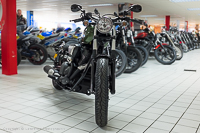
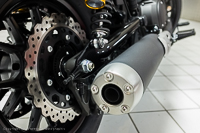
I have sourced a gear indicator for
the Yamaha Bolt which is the USA
version of the Yamaha XV950 motorcycle. It is the
Glpro-X Type (Part No: GPX-Y01)
manufactured by
Healtech-Electronics and it costs
£99.99 vat inclusive in the UK.
NOTE:
In the Yamaha Dealer's workshop, it was established that the
Glpro - X Type
gear indicator was designed for the non ABS Yamaha XV950 (USA Bolt
Variant) and cannot be fitted to the UK R Spec model due to the ABS
system which would involve cutting into the wiring loom and invalidating
the Yamaha Warranty.
From the Healtech Website - "No
matter what bike you own, we have a solution for your ride. The GIpro
with ATRE and GIpro DS-series models have limited compatibility. The
GIpro X-type models will work on all motorcycles, ATVs, cars and other
vehicles with 4, 5 or 6 gear positions.
To make the installation as simple as possible, we offer plug ‘n go
harness kits for hundreds of different bikes. Universal harness kit is
also available and there’s a kit too for older bikes with cable driven
speedometer which work great even on bikes without a speedometer, like
off-road motorcycles.
Thanks to a modern microprocessor and sophisticated firmware which was
polished for years and installed on thousands of vehicles, the GIpro
X-type offers endless compatibility, quicker response and more reliable
readings than any competing product".
_______________________________________________
If I purchase the Yamaha XV950R motorcycle I will have to consider a means of storing my helmet and gloves on
 the bike whilst I am in the town. This
is a bike that I will use frequently for
the bike whilst I am in the town. This
is a bike that I will use frequently for
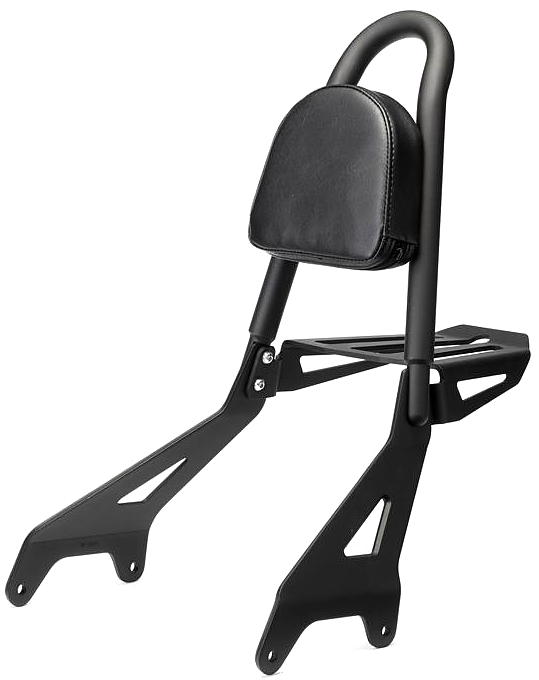 urban travel including night
time and meeting up with friends as well as my hobby of street
photography.
urban travel including night
time and meeting up with friends as well as my hobby of street
photography. Yamaha do supply a rack for the back of the bike that can take up to a 4.5Kg load but it is part of the back rest/small sissy bar frame system and (apparently) has to be purchased in 4 parts. They also do a larger sissy bar which costs an extra £20.50. The main difficulty is in determining the size of the rack so as to figure out what storage box mounting bracket would fit.
I have put together a (possible) purchase list -
| Description | Part Number | Price |
| Bottom Side Arm Brackets | 1TP-F84AO-V0-00 | £99.49 |
| Short Back Frame (Long Back Frame add £20.50) | 1TP-FP16T0-V0-00 | £118.49 |
| Back Frame Support Pad | 1TP-F84B0-V0-00 | £83.99 |
| Luggage Rack | 1TP-F48B0-V0-00 | £133.99 |
| TOTAL: | 4 Parts | £435.96 |
A possible top box could be the
GIVI 42L Trekker Outback Black Line Case
which is more 'retro in appearance' than a
 standard GIVI top box. The
Trekker Outback 42L plus a GIVI universal mounting plate costs
£323.94.
It measures out at 12.7" in height, 16" in width and 17.87" in depth
and is easy to fit and remove from the mounting plate by the use of the
locking key and the box main tab release. I think the larger sissy bar
would be a better option as the bike overall would look more
aesthetically in proportion with the case fitted.
standard GIVI top box. The
Trekker Outback 42L plus a GIVI universal mounting plate costs
£323.94.
It measures out at 12.7" in height, 16" in width and 17.87" in depth
and is easy to fit and remove from the mounting plate by the use of the
locking key and the box main tab release. I think the larger sissy bar
would be a better option as the bike overall would look more
aesthetically in proportion with the case fitted.
The new version of the 42Ltr top-case does not require any special rack
as it can be attached to any Monokey plate and GIVI supply an
(optional)
E251 Monokey Universal Mounting Plate to fit most bikes with a rack. The TREKKER OUTBACK
42 Ltr top-case offers the possibility to load a full-face or a
modular helmet
plus other items such as gloves.
The flat lid and four strap loops are the standard
equipment of the OUTBACK cases, and offer the possibility to store
objects even on the top of the lid, while inside it is possible to
secure items to the underside of the lid with an elastic net
(optional) which can be secured with existing hooks.
Among the standard features is a mat made in soft material, which
placed on the bottom of the case will absorb shock transmitted
during riding.
It sure is an expensive way (£780.40) to mount a tall sissy frame
and rack with the Trekker 42L top box on the bike but so far I have not
found an alternative and cheaper 'retro styled'
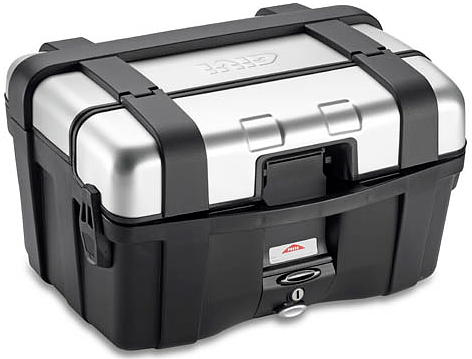 option for carrying
around and picking up stuff as well as leaving my helmet and gloves
secured.
option for carrying
around and picking up stuff as well as leaving my helmet and gloves
secured.
Another possible top box could be the (slightly smaller in
overall size)
GIVI TRK 46N Trekker which is a
Monokey design. This box is made out of plastic with an aluminum finish and costs £210.44 vat
inclusive in the UK.
It has a 'retro' look which should bode well with the bike
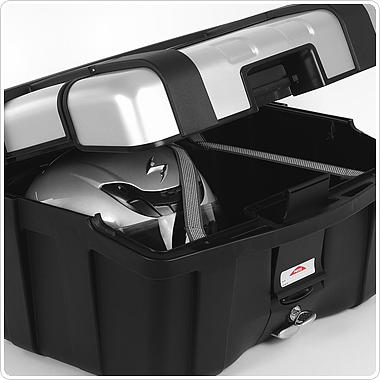 for style and
because it is rounder, the look is quite appealing and not so harsh as
the 42L.
for style and
because it is rounder, the look is quite appealing and not so harsh as
the 42L.
This 46 litre GIVI Trekker Top Box
is exceptionally practical for a couple of reasons.
For starters it can
be used as either a side case or a top box, but furthermore it has a
unique lid which can be opened fully in the standard fashion or a
smaller section of the lid can be opened – a feature which is especially
useful when the box is being used as a side case.
On top of this, GIVI's revolutionary Monokey system allows for easy locking and
attachment. The GIVI TRK46N Trekker can fit a wide selection of
accessories,
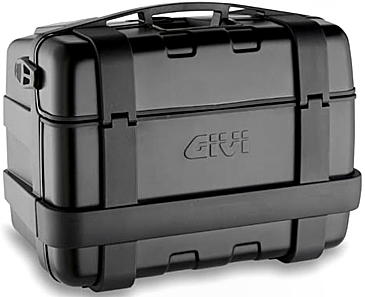 such as the GIVI E125 Four Rings Kit which can attach a
carry net to the Trekker 46 to allow for even more luggage capacity.
such as the GIVI E125 Four Rings Kit which can attach a
carry net to the Trekker 46 to allow for even more luggage capacity.
GIVI have released the
GIVI TRK 46B Trekker case which is
the black version which is made out of plastic with a black aluminum
finish and looks even more retro than the aluminum one.
The Trekkers' do not require any special rack as they can be attached to any Monokey
plate and GIVI supply an
(optional)
E251 Monokey Universal Mounting Plate to fit most bikes with a rack.
The TREKKER top-cases offer the possibility to load a full-face or a
modular helmet plus other items such as gloves.
_______________________________________________
A 'Bobber' is a great bike but the Yamaha XV960R ABS has a relatively hard sports rear suspension that might impact on the sensitive tailbone of some riders. Whilst travelling on the smooth country roads and the dual carriageway the ride is fairly comfortable; however, it is a different story when travelling over the unevenly repaired and pothole ridden roads of Edinburgh. You cannot avoid all the potholes and if you hit a deep one the jar up the base of your spine is a severe one. If you are like me and weigh in at around 15 stone, I would caution against softening the rear suspension as the default settings for the Yamaha XV950R kept the rear tyre well planted and made the bike a breeze to ride on wet roads and even over wet cobbles. It is now extremely likely that I will purchase the Yamaha and the only change I would make is to fit a Mustang Solo spring/sprung seat to raise the seat height from the frame and to prevent serious jarring to my spine over potholes that I could not avoid.
Without a doubt, an optional Airhawk R Aircushion which is specifically designed for men and relieves pressure on the tail bone, the scrotum and the prostate areas of your rear will help absorb the rigid impact from the rear suspension and you could even fit (if required) an optional spring/sprung seat to further dampen the suspension. The beauty of this twin solution is that the rear suspension of the bike can be left at it's standard factory default settings if required or adjusted to suit the weight of the rider vs the grip of the tyres on the road. The downside is that when fitting a spring/sprung saddle you may have to remove the stock pillion passenger seat and fit a third party pillion seat or a billet rack on the fender where the pillion seat was situated?
Yamaha supply an optional brown leather seat for their XV950R which is apparently a
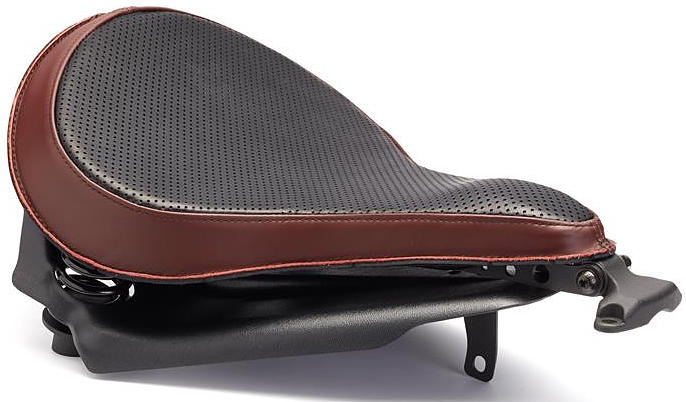 great
deal more comfortable that the stock seat -
great
deal more comfortable that the stock seat --
Integrated spring suspension
-
Molded Frame Cover
-
High-quality leather panels
All electronics hidden for a clean look
There is
no doubt that this
brown saddle Part No: 1TP-F47CO-V0-00 will
greatly ease the pressure off your bottom when riding the Yamaha
XV950R motor cycle. Potholes and rough roads should be less of a
problem and because you can remain seated, a lot easier to
negotiate. The downside is that this leather saddle costs £411.99
in the UK.
There is a third
 party
Spring Solo Seat solution (black) from Mustang that
seems ideal, although you may require to remove the stock
pillion seat and source a third party option that works with the
Mustang? Alternatively, you could remove the standard stock seat from the Yamaha XV950R and install
the solo rider Mustang seat
and a
Yamaha Billet Rack where the
pillion seat used to be situated.
party
Spring Solo Seat solution (black) from Mustang that
seems ideal, although you may require to remove the stock
pillion seat and source a third party option that works with the
Mustang? Alternatively, you could remove the standard stock seat from the Yamaha XV950R and install
the solo rider Mustang seat
and a
Yamaha Billet Rack where the
pillion seat used to be situated.
Removing the existing twin suede seat arrangement is a piece of cake
and the billet installation is simply a 4 screw fitting where the
pillion seat was fixed onto the fender - see billet fitted on the
rear fender in the following image -

Most Yamaha Dealers have access to third party
Mustang
parts - check out all the
Mustang Spring Solo Seat Components including the
Yamaha billet rack and
the following links for a European Purchase. Please note the Mustang Spring Solo Seat Part 76985
and the Mustang Spring Kit Part 78160
are purchased together and the Spring Solo Pouch Part 78154 is
optional.
I have included a
YouTube
video of the complete Mustang Spring Solo seat installation -
For those riders with a sensitive rear, the AirHawk is an alternative solution to changing the stock seat. It is an air cushion that is fitted on top of the bike seat and inflated to suit the rider's comfort. AirHawk can be purchased in the UK through Amazon -
The
AirHawk R is specifically designed for men and relieves pressure on the tail bone, the scrotum and the prostate areas of your rear -
Check out this Airhawk R Review from a Revzilla.com Customer -
"I've had this cushion for about 5 hours of riding on my 2014 Yamaha Bolt. The Bolt has a uniquely uncomfortable seat position especially for big guys like me (6'3" and 34" inseam). This cushion of air gets the delicate parts off the rigid, non-cushioned portion of the Bolt's seat. Before this cushion, I was ready to sell my Bolt for something much more comfortable (like the Honda or the Harley, of which I am not a fan), but I quickly changed my mind. The pain and discomfort that was building over the past 7 months on the Bolt vanished in an instant. I highly recommend this air cushion for anyone suffering during a long cruise on a great bike. No point in trying to enjoy the bike when the seat makes it unbearable". Rides: 2014 Yamaha Star Bolt - Yes, I recommend this product.For those riders with a sensitive rear who would prefer a Gel Pad fitted to their bike stock seat there is a good selection of various sizes from
DanMedicaSouth. These gel pads can be supplied in a cover with Velcro straps that hold it down onto the top of the seat or if there is enough material in the stock seat cover, you can undo the fastening of the seat and slip a 'made to measure' gel pad under the cover and refasten it -
_______________________________________________
The touring luggage for short week-end breaks is fairly straightforward and it is the same backpack that I use with my Suzuki 1250FA motorcycle. It is unlikely that I would use the Yamaha
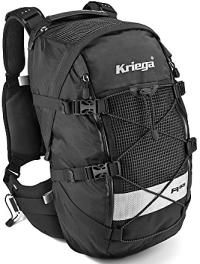 XV950R for touring trips
but the
Kriega R35 Backpack carried on my
back would be ideal for those trips into town where I might be
purchasing a larger item that will not fit in a top box.
XV950R for touring trips
but the
Kriega R35 Backpack carried on my
back would be ideal for those trips into town where I might be
purchasing a larger item that will not fit in a top box.Initially, I discounted the idea of a backpack because if I took a spill then the contents could dig into my back, however the Kriega range of motorcycle backpacks have an optional large back protector inserted inside which is an added bonus to the one already in my jacket.
I have used a backpack for my photography and even used one on trips abroad without any hassle and the Kriega R35 is well supported without placing any strain on my shoulders.
The backpack in the video is the smaller R25 day pack but it is very similar to the R35 (see image) which I think is the ideal size for more week-end clothes - click image to open up to a larger size.
_______________________________________________
Crash Protection + Extensive Accessories List
The Yamaha
 XV950R motorcycle has a heavy
V-Twin
engine and the fins look terrific but I would hate to drop the
bike and don't say it can't happen because it can. The simplest way
to drop a heavy bike, even one with a very low centre of gravity, is
to stall it as you move away when negotiating a sharp turn at a
junction or of course wrongly dismounting and stumbling whereby the
bike tips over too far to be recovered.
XV950R motorcycle has a heavy
V-Twin
engine and the fins look terrific but I would hate to drop the
bike and don't say it can't happen because it can. The simplest way
to drop a heavy bike, even one with a very low centre of gravity, is
to stall it as you move away when negotiating a sharp turn at a
junction or of course wrongly dismounting and stumbling whereby the
bike tips over too far to be recovered.The thought of a cracked fin doesn't bear thinking about but Yamaha offer engine protection bars Part No: 1TP-F43B0-V0-00 that match the aesthetics of the bike.
These bars are bolted onto the frame and costs £159.49 in the UK.
Yamaha offer an Extensive Accessories Parts List and I am fairly sure that UK third party manufacturers' will start to produce their own add-on options for this bike. In the USA J&P Cycles and Mustang have already started an extensive catalogue of Yamaha XV950R (Bolt R in the USA) add-on parts.
Most parts for the Yamaha XV950R (Bolt R is the USA) can be sourced through European and UK suppliers, check out this Low & Mean (Bolt 950 conversion) machine and watch it's adjustable suspension in the video clip -
_______________________________________________
Well I finally managed to get my hands on a Yamaha XV950R demonstrator (18/10/14) and take it out on the road for a few hours. I enjoyed a mix of weather, bright, warm, sunny and massive winds on the dual carriageway, interspersed with torrential rain in the city. My thanks to Saltire Motorcyles for the use of their bike.
The XV950R is 'old world' style so I managed to create a few atmospheric images of the bike with my Fujifilm X100s compact camera. The main image below includes the Yamaha XV950 model as I was joined late in my trip by another biker, so we stopped for a chat whilst I was using the camera in Edinburgh.
First Impressions
It looks like a piece of history, a bike that someone
left lying in their garage for about 60 years which has been rebuilt,
repainted and sits outside on the forecourt begging to be ridden.
Starting the Bike and Moving Off
The Yamaha XV950R is equipped with a immobiliser system which is coded to your
ignition key so no other key can be used.
A master re-registering key is provided in the sales package to code the
2 ignition keys supplied with the bike. If required, you can take the
bike and the 3 keys along to a Yamaha dealer and get the ignition keys
re-registered with new codes.
Currently (2014) Edinburgh has a high rate of motorcycle thefts
which is mainly down to the absence of police on the street preventing
crime so it is here that the Yamaha XV950R with it's immobiliser
(true coded key) system comes into it's own. It is easy to snap a
steering lock and turn an ignition switch but without that code the bike
will not start - so joy riders in Edinburgh are likely to choose another
bike. However a sturdy disc lock fitted to the front disc is an
advisable accessory and you can purchase one with an audible tamper
alarm. Make sure that you check the size of the disc lock assembly as
smaller disc locks can slip through the hole in a larger bikes disc
plate.
To unlock the separate steering lock in the steering arm you use the
ignition key and the same key is then used to start the bike from the
ignition switch down on the right side of the bike in front of the
petrol tank. Interestingly enough you only require to be in neutral to
start the bike using the ignition switch and the starter button, the
clutch lever does not have to be depressed (unless you are in a gear).
However, if the side stand is down the engine will cutout immediately
you select a gear or if you are in a gear the bike will not start, even with
the clutch depressed - the stand must be up before any gear can be
selected prior to moving off, a nice safety feature.
The XV950R is air cooled so it is advisable that the engine is not
started purely to be left running whilst you go back into the house for
your stuff. This could become habit forming, especially during the
winter months when leaving the bike to heat up before you ride it.
Once started the XV950R barks, growls and you can feel the vibration
coming through the handlebars. You know this thing has some fierce V
twin power and apparently it is a lot louder when you are following it
from the rear as a fellow biker remarked later in my test trip. The two
mirrors were easily adjusted and gave me enough rear coverage without
protruding beyond the handlebar ends and the overall width of the bike.
The main controls are well placed and very easy to use although the
digital instrument panel leaves a lot to be desired - I would have
preferred an analogue one.
The throttle is very responsive and controlled, there is no sudden
uncontrolled spurt from rest unless you want to open it up and then
you will feel that awesome surge as the bike rockets forward. It may
look 'old world' but the XV950R is no underpowered machine. I could use
the clutch lever all day without any hand pain which is ideal for use in
heavy traffic where there is a lot of stopping and starting.
Coming from my sports/tourer, I found that the Yamaha was a delight to
sit on with my feet easily reaching the ground and much more leverage at my
disposal. I had to remember not to attempt to squeeze my knees against
the tank and ride in a more straight legged position lest my knees
bumped into the protruding parts of the bike on either side - not a
problem once you get used to it. The bike has a very low centre of gravity so I felt really
confident and relaxed with my feet down and the handlebars were nearer
which took away any doubts that I had about supporting the bike from the
middle pegs seating position. However when I did set off and be warned,
I kept trying to find the pegs position of my sports bike, so for the
first few miles, my feet were dangling a lot when I moved away from
traffic lights as I tried to establish the Yamaha foot pegs position.
The Suspension
I am probably not the best rider to review the suspension as I suffered
an injury to the base of my spine in my teens. The riding position on the Yamaha XV950R is upright, with the
handlebars pushing the body back onto it's base and the legs brought up
at the front placing more pressure on the base.
The rear shock absorbers on the bike for my test run were set-up in the
factory default position
and right from the start I felt the ache in the base of my spine which
for the next 2 hours did not fade but on reflection I am now fairly sure
that this was more down to the upright riding position which places all
the body weight down on your tailbone. However, there is no doubt that when riding on the rougher
roads in Edinburgh, especially going over the pot holes, the bike
suspension jarred my spine even more and so much so that I had to stand
on the foot pegs when going over a rough road and clear my rear from the
saddle. I think the rear lip of the saddle was a problem for me because
with my 33" inside leg, I found that my rear was pushed back against the
lip and I was aware off it when I was riding the bike.
You cannot avoid all the potholes and
having gained more experience on this type of motorcycle
and riding around the city streets, I would caution against softening
the rear suspension as the default settings for the Yamaha XV950R kept
the rear tyre well planted and made the bike a breeze to ride on wet
roads and even over wet cobbles. It is now extremely likely that I will
purchase the Yamaha and the only change I would make is to fit a Mustang
Solo seat to raise the seat height from the frame and to prevent
serious jarring to my spine over potholes that I could not avoid. The
Mustang Solo seat is spring/sprung and should help cushion any grounding of the suspension as the seat is
no longer 'hard against' the frame of the bike.
I intend to ride an 'urban' motorcycle solo at all times so the default
factory settings of the Yamaha XV950R's suspension suited my 15 stone
weight. The Yamaha can be adjusted for pre-load at the rear but this is
an area where I would get a qualified dealer to make the finer
adjustments if there were any major change to my body weight.
Another fantastic option is the Airhawk R air cushion which is
strapped to the top of the stock seat. The R version
is specifically designed for men and
relieves pressure on the tail bone, the scrotum and the prostate areas
of your rear.
Please check the
Seat 'Comfort' Options Section.
On the Dual Carriageway
I roared up the slip road onto the dual carriageway and joined the flow
of traffic. The bike snarled and the gear changes were slick and
effortless, both up and down the box. The XV950R demonstrator was a
brand new bike and it did not have a rev counter, so I tended to keep
the revs down and move up the box well before I stretched any gear
anywhere near it's limit. Even with the rev limitation, the bike was up
at 70mph in a very short time and cutting through the heavy wind and the
cross winds without any fuss or threatening behaviour. Although it is a
naked bike and there is no windscreen, I never felt that the heavy wind
was buffeting me and causing any kind of instability, even at 70mph. The
bike was well planted and I felt that if I opened it up, the heavy wind
would still not pose a threat to the stability - it is one large chunk
of metal with a massive amount of torque and the very low centre of
gravity certainly pays off in high winds. I often found myself seeking a
6th gear (my Suzuki GSX-1250FA has 6 gears) when accelerating up
to and even at 70mph the bike's top 5th gear had so much torque that my
brain had my left foot fiddling to find a non existent 6th.
You can feel the vibration through the handlebars gather momentum as the
speed increases and it takes quite a bit of getting used to but within
half an hour I had become so accustomed to it, that it no longer
bothered me. However, the wing mirrors were a different story because as
the speed increases on the dual carriageway, the view in the glass
becomes blurred especially if you have two or three cars following in
the outside lane, their images merge, especially if they have their
headlights on and I found it difficult to judge their distance. Slightly
irritating but it just means much more lifesavers rather than any
reliance on the mirrors.
The XV950R has solid ABS brakes and they effortlessly pull the bike up
when required. I never applied them to the limit at anytime and I was
careful with them as they had not been run in and neither had the tyres.
However, even in the heavy wind and rain, I never had that moment,
where I felt they could not pull me up. On the long sweeping roundabouts, I managed to scrape a foot peg on the road and
only because I forgot I was on a bobber and not a sports bike. There is
no doubt that the XV950R could lean over a lot more and I had to remind
myself that I was testing the bike for urban city use and not sports
manoeuvres.
Slipping between dual carriageway lanes and stationary cars and lorries
at 15mph is a breeze, even at 6mph and I always felt in total control
even with both my feet on the pegs. This bike has such a low centre of
gravity that very slow (almost stopped) speeds, are not a problem
and much easier to control than my higher seated sports bike. Popping
the XV950R up to the front at the lights and then a crisp acceleration
with a snarl from the exhaust is a great feeling as the traffic is left
behind. The low seat on the Yamaha with the centre pegs and (nearer
the chest) handlebars is still a commanding position and encourages
confidence in your riding at all speeds.
The Instrument Panel + Controls
I can live with the instrument panel but I don't like a digital display. It has all the necessary warning lights for failure, ABS,
oil, immobiliser, etc but when you look at it, all you see is a large
square window displaying your numerical speed.
I
appreciate that the XV950R is a minimalistic
(garage built) style bike
but
Yamaha really should get their act
together
and
include a gear indicator and a rev counter on a nice
 'retro'
digitally driven analogue style bezel with the indicator direction
lights set brighter,
larger and further apart.
'retro'
digitally driven analogue style bezel with the indicator direction
lights set brighter,
larger and further apart.
The gear indicator, I feel
is an necessity
because the bike with it's V twin is fearsome for
engine
braking when
de-accelerating, even in 4th gear and has such a high level of torque that it is
sometimes hard to judge what gear you are in. Perhaps I am being
pedantic and for sure, I know that once I have ridden this bike for some
time, the gears and the revs will come naturally to me, so at the very
very least Yamaha, ditch the digital stuff for analogue to properly add
a nice finish to the bike.
The main controls are well laid out as you would expect to find them,
indicator switch, horn, hazard lights, main beam, etc. The clutch
operates very smoothly and even after continual heavy use in traffic
there is no hand pain. The gear shift is most excellent, slick in
operation and with plenty of room to operate with your left foot.
I don't like the separate steering lock idea, I would much prefer an all
in one steering/ignition lock set-up on the top of the bike. The worse
part is that you have to get off the bike or lean right over the side of
the petrol
tank to switch off the ignition and then use the same key to put in the
steering lock to lock that.
Cruising in the Countryside
It does not get much better, the ability to cruise along sedately on
country roads, to hear the snarl of the engine when you pop it a bit on
a clear straight but always mindful of tractors and stray animals but in
the knowledge that the bike has plenty of stopping power thanks to it's
ABS brakes. You have to be mindful as well that this bike can corner low
but the build of the bike with it's low pegs will restrict the angle
whereby you will hear the underside of the foot peg scrape. In any case the
main reason for purchasing the bike is to enjoy it for 'urban' use and
for cruising country roads and taking in the scenery - easy to
manoeuvre
and easy to stop and park, not race around corners like on a sports bike.
In the City Traffic
I did suffer some severe jarring to my spine when I hit the deeper potholes in the road but I am sure the optional Mustang Solo seat with it's springs to cushion the seat from the frame will take care of that or at the very least lessen the pain. It high time Edinburgh Council got their finger out and fixed the roads and whilst they are at it put more policemen on the street to prevent crime.
The seat height is 690mm (27.17") and you sit reasonably high in the saddle. Seat height is sometimes overlooked when testing a bike and often the rider wants a low seat but if the seat is too low the strength and purchase in the legs can be compromised just as much if the seat was too high. The bike's weight with a full tank, the rear suspension setup, the rear tyre grip, the throttle control, braking capability, the pegs positions and even seat height in relation to the size of your legs plus your overall view of the street and traffic, all play an important part in enhancing your safety on city roads. The 'urban' novice rider might assume that riding a sports bike on twisty country roads at speed is dangerous and likely to lead to injury BUT there is a greater likelihood of injury riding the wrong bike in city traffic.
Some interesting stats regarding other motorcycle seat heights -
-
Victory Gunner - 635mm (25")
-
Indian Scout - 643mm (25.31")
-
Yamaha XV950R - 690mm (27.17")
-
Harley-Davidson 1200 Sportster - 710mm (27.95")
-
Harley-Davidson 883 Iron - 735mm (28.94")
-
Yamaha MT-07 - 805mm (31.69")
-
Suzuki GSX-S1000 ABS - 810mm (31.9")
This
Yamaha XV950R is ideal for city
traffic, stopping, moving off, slow, fast and it goes exactly where you
want it to go and U turns are a positive joy to negotiate. NOTE:
I used the same very steep cobbled road as the road test on the
Yamaha MT-07 Motorcycle - it is the ultimate
for 'urban' testing of slow control
manoeuvres,
suspension and braking.
_______________________________________________
Even the stock exhaust has enough of a snarl to produce loud pipes and
heads turn, car drivers hear you and they see you and if there is any
doubt, you can blip the throttle for a loud warning that you are there
beside them. The bike is easy to park, it's so low that if you have to
dismount to move it into an awkward parking space, there is no hassle.
The side stand is long and supportive and relatively simple to operate.
_______________________________________________
In the end I decided that I liked the idea of a minimalistic approach,
so I would remove the pillion seat, the pillion pegs, the stock seat and
I would fit the Mustang Solo spring/sprung black saddle and the Yamaha
billet rack (black) in place of the pillion seat on the rear
fender.
Quick Review
(5th
March 2015)
First let me state that the Yamaha XV950R with ABS brakes is one of the
most fun motorcycles I have ever ridden.
I am so taken by this bike and the pure exhilaration that it
delivers that I will probably purchase one for April 2015 delivery.
The Yamaha is aimed specifically for 'urban' use, riding around the city
and in that respect it ticks all the boxes for me. The essential rear
tyre grip and ABS braking to handle extreme wet roads on tar and over
cobbles in Edinburgh is excellent albeit with careful throttle control
as the engine does produce awesome torque throughout the gear range.
Fortunately the throttle control is par excellence and combined with a
very light clutch control and gears designed for urban use, it makes for
very pleasant handling with much less chance of those awkward moments.
Make no mistake, the Yamaha XV950R is the ultimate 'bobber' with a
V-twin engine that is just awesome with it's massive endless torque,
sheer power and a stock exhaust that is sufficient to produce that snarl
and growl that makes a statement. The bike is alive, it slightly
vibrates, you feel the 'raw' power you can unleash and yet at a very,
very slow walking pace it is easy to steer and control. These qualities
make it the ideal bike for 'urban' travel in the city, a bike that has
such a low centre of gravity it does not pose a problem for
maneuvering,
parking and for seamlessly slipping up the lanes of traffic.
The
stock seat height of 690mm (27.17") is high enough for me at 6'
with a 33" inside leg, so I can gain a decent view of the traffic
conditions and my seating position with the midrange foot controls and
close placed handlebars gives me a commanding feeling when handling the
bike. The seating position takes a bit of getting used to, especially if
you are coming from a sports/tourer bike because your body weight is
placed backwards and down onto your rear. I did not have the luxury of
spreading my weight onto my thighs so with a previous spine injury I did
feel the dull ache on my rear from time to time but this was more
apparent when cruising on longer trips. The suspension at factory
default settings is excellent but the downside is that over some deep
potholes (you cannot avoid them all) it gave me some serious jars
to the base of my spine as the rear suspension grounded.
Having gained more experience on this type of motorcycle
and riding around the city streets and if you are a solo rider and a
similar 15 stone (around 210lbs) weight to me, I would caution against softening
the rear suspension as the default settings for the Yamaha XV950R kept
the rear tyre well planted and made the bike a breeze to ride on wet
roads and even over wet cobbles. The only change I would make is to fit a
Mustang
Solo seat to raise the seat from the frame and to prevent
serious jarring to my spine over potholes that I could not avoid. The
Mustang Solo seat is spring/sprung and should help cushion any grounding of the suspension
as the full base of the seat is no longer on the frame of the bike.
This is a bike that is also ideal for short countryside 'cruising' trips and
responsive handling with powerful overtaking even in the top 5th gear -
the torque is that good, although I often found myself seeking a 6th
gear. It is well planted at 70mph on the dual carriageway with no hint
of any stability issues, even in high winds and during 'brief' faster
overtaking speeds in heavy winds the stability is still not an issue as
it cuts through with ease and cross winds do not budge it.
The ABS brakes felt responsive and pulled me up with ease, even with an
emergency stop at 70mph, I never felt threatened by lack of stopping
power and bearing in mind that the bike was brand new with new brake
pads and new tyres so I was sympathetic with the braking. The brakes can
only get better as everything beds in during the running in period.
The odd dull ache on the rear of my spine that I experienced when on
cruising trips is a direct result of inactivity in my old age and is an
area that I am addressing. I doubt that younger riders with fit backs
and strong muscles will suffer the same. For me, the Mustang Solo seat
will help and I also intend to strengthen those back muscles with more
exercise and riding my motorcycle on a regular basis has already
strengthened my back and side muscles.
Yamaha have a reputation for manufacturing motorcycles with excellent
build and reliability. The Yamaha XV950R certainly comes across as a
motorcycle that will maintain that reputation. It is not a Harley-Davidson 883
Iron and the Yamaha is unlikely to hold a higher residual value
but nevertheless a reasonable one. However, most bikers will come to recognise that the Yamaha XV950R is a bike worth riding
and owning without any long-term mechanical concerns.
Now that I have ridden a 'post war style' garage built 'bobber' I can
finally understand the attraction, the exhilaration, the power and the
sheer enjoyment of the Yamaha XV950R motor cycle.
I
raised a purchase order (11th March 2015) for the Yamaha XV950R motorcycle
with
Saltire Motorcycles in Edinburgh and
I should take delivery of the bike in early April 2015 -
Yamaha XV950R ABS Motorcycle
(Matt Grey)
Indicators - Audible Bleeper
Mustang Spring/Sprung Saddle +
Frame
Assembly (Black)
Yamaha
Billet
Frame
(Replaces Pillion Seat)
Yamaha
Engine
Protection Bars
Indication is essential to warn other drivers of your intentions and just as important is to remember to cancel the indicator due to the many junctions in the city. So I will fit an indicator beeper to audibly warn me that the indicator is switched on and to remind me to switch it off.
Also riding on wet roads, especially cobbles could lead to the bike suffering a drop, so protecting the engine is a worthwhile consideration. I decided to go for the engine protection bars from Yamaha which are not so large as to detract from the look of the bike.
Anyway, I plan to include some images of the bike when it is kitted out and add an addendum to my review after I have ridden it for about 1,000 miles.
_______________________________________________
Addendum
I
picked up my new Yamaha XV950R motorcycle on the 4th of April 2015 from
Saltire Motorcyles
in Edinburgh who had fitted crash bars to protect the engine and an
audible bleeper to the indicators. After riding it home, I made some
modifications in my garage.

Removing the stock seat and the pillion seat was relatively
easy and I followed the instructions to fit the Mustang solo
spring seat using the supplied manual and followed the Mustang video
(see seat comfort options section above) which was a great help.
However, it is advisable prior to any fitting to plug any frame holes
with paper just in case you drop a part and it disappears down inside
the frame - it happened to me when fitting the billet rack and I spent
ages fishing out one of the spacers that had dropped down the inside of
the fender.
The Mustang seat when fitted sits high on the frame or at least it
appears to be higher (it's actually the same height as the stock
seat) and the bike's electrics below it become visible, especially a
red wire. I temporarily fitted some black plastic sheeting over the
frame under the seat to conceal the wiring until I can source a black
rubber mat cut to lie inside the frame (triangular shape) which
will prove more substantial.
I also placed the bike over some newspapers and used a can of
Well that's the bike ready for the road and it only has 3 miles on the clock, the distance from Saltire Motorcycles to my home. I am looking forward to running it in and it gets it's first service at 600 miles and will be completely run in at 1,000 miles.
The Mustang Spring Seat
The Mustang spring seat soaks up the largest and deepest of potholes without any impact on my rear end. The extra suspension of the springs at the rear of the seat makes all the difference. I would have liked a slightly larger seat area as it is marginally smaller than the Yamaha stock seat but it is by no means a deal breaker.
However, it has one serious flaw, because when you accelerate very fast,
especially from a stationery position, the seats rear springs move
backwards as your rear end is pushed back into the seat and this has the
effect of placing a serious (lifting) load on the front of the
seat. This load uses the triangular front bracket's two rear locating
pins (in frame underneath) and the
L bracket which is wielded to the rear/underside of the triangular front
bracket (used to secure the rear of the triangular front bracket to
the frame using the stock bolt)
to create a fulcrum whereby the front of the seat and the front of the
triangular bracket are pulled up and then down as the bike
accelerates/decelerates. I weight 15 stone, so the impact on the L
bracket's securing hole was severe whereby it became
distorted due to the load turning the L plate on the securing stock bolt.
This problem only arose when I started to open up on the acceleration
(once I had put some mileage on the engine) and no matter how tight
I made the stock bolt, the L bracket still managed to (eventually) turn itself.
Obviously the total answer would be to spot wield the the seat's
triangular front bracket to the frame but I am not keen to do this as it
would invalidate the bike and the seat warranty.
My solution is to strengthen the L bracket (at it's
securing hole) by using a large flat washer to provide a greater
friction area as the stock bolt sandwiches the L bracket between the
flat washer and the bike frame's stock bracket. I have also secured the front
of the
triangular bracket
to the front of the bike's frame using a large nylon cable tie wrapped
around the back of the swivel bracket which secures the seat to the
triangular bracket. Hopefully these added securing measures, especially
the cable tie, will prevent the seat from lifting at the front under
harsh acceleration. I am still working on a long-term solution because I
really like the Mustang seat but the cable tie is not out of place as
the bike has a few (factory fitted) dotted here and there on the
frame.
The much harder standard stock seat does not suffer from this 'lifting'
load effect as the stock seat is hard fixed to a bracket at the rear on
the bike's frame whereby the rider's weight is equally distributed under
harsh acceleration.
Since making the modifications, I have put the Yamaha XV950R through
it's paces (some 200 miles) and the Mustang Solo seat has not
shifted.
The Yamaha XV950R 'Bobber' is designed primarily for 'urban' use and the gearing of the bike is well suited for the purpose. However, I had made modifications (see above) to my Mustang Solo seat so I decided that I would test it out on a country road trip and place it under serious stress. My planned route started from Edinburgh on the A702 city bypass then the A701 to Moffat. The road back to Edinburgh would be via the A708, up and over the hills to St Mary's Loch, swinging left on the B709 to Innerleithen and then the A72 to Peebles and the A703 back to the A701 at Leadburn for Edinburgh.
I filled the tank up and kept the bike within the speed limits (the country roads were 60mph) and at 113 miles the reserve fuel petrol light came on along with the reserve trip counter. I was not cruising because my route had some serious twisty bits in amongst rising crests, climbing hills, narrow hump back bridges and cracking corners. What a route to take and I had some terrific fun with hardly another vehicle insight apart from other bikers enjoying the same scenery as me. I stopped at Moffat for lunch and the town was full of bikers parked up and some passing through on their way to the Glen Cafe Bistro up at St Mary's Loch.
It was a brilliant day, the sun was out, the sky was clear but once on the road, all I could see on the Yamaha instrument display was my speed. Forget about anything else and when I indicated to turn left or right, I could hear the audible bleeper (optional part) telling me the indicator was working but the almost invisible indicator light on the panel was a joke. I have been riding motorbikes since May 2014 and I started on a Suzuki 650cc training bike that had a gear indicator and then in August 2014 purchased my own Suzuki GSX-1250FA sports/tourer which also had a gear indicator, so riding the Yamaha XV950R without one was a neat learning curve. I thought it was going to be a serious problem but after a few hundred miles, changing gears without a gear indicator became as natural as breathing. The Yamaha main controls, starter, trip switches, indicators, flasher, horn and hazard warning switches were all the correct size and in the places you would expect them to be and very easy to use, a real joy. The clutch lever could be used all day and all night and there would be no wrist or finger pain and the 'handlebar grips' vibration which increased with speed was just what I wanted from the bike. I love the interaction that I get from the Yamaha XV950R, the sound, the vibration and the low down torque which seems endless through the gears. Despite the very warm day, the engine heat was not over the top to the extent that I was unaware of it until I stopped the bike.
The Yamaha XV950R behaved flawlessly, rising fast over the crests then down on the twisty corners and the handling (stock suspension settings) was terrific. The acceleration through the gears was crisp and the brakes easily pulled me up whenever I overstepped myself - not once did the brakes lock thanks to the ABS system. The rear brake on its own is brilliant for travelling in city traffic (experienced in Edinburgh) with excellent rear wheel stopping power without any locking. The bike had one limitation which was the lean angle with the pegs grounding on the roadway on some of the tighter corners. Thanks to the Mustang Solo seat springs, I never experienced any spine judder when the rear suspension bottomed out but after about 40 miles in the saddle I could feel a dull ache in my lower back due to the seating posture which required a 20 minute rest before it subsided and I was ready for the next 40 miles. The upright seating/legs position (for me) is not ideal for long trips and I found that I was arching back my spine to relieve the ache until I stopped for a rest.
Without a doubt the Mustang Solo spring seat is miles (literally) better than the stock seat for soaking up the jolts from potholes and so far my modifications have ensured that it does not move on it's securing bracket. I would not make a habit of taking the Yamaha out on long trips in the country but for 'urban' use and short country trips the bike is a blast to ride without the slightest discomfort. The handling is phenomenal and combined with the crisp acceleration, the stock exhaust note and the excellent brakes, the Yamaha XV950R puts a smile on my face.
_______________________________________________
Motorcycle Battery ChargerWith all those October 2015 weather forecasts of imminent snow storms for the next few months in Scotland and a prolonged hard winter; it is unlikely (if there is snow) that I will be out and about on my motorcycles.
I got to thinking that I require a battery charger for maintaining the batteries whilst the bikes are laid up but I wanted the convenience of leaving a battery connected on a bike whilst a maintenance pulse charge was being applied by the charger.
I figured that I would only require one charger and 2 sets of eyelet leads, each lead hardwired to a battery terminals with it's flying lead socket used to connect to the charger lead plug as opposed to using the crocodile clips. I plan to alternate the charger between the 2 bikes every couple of days. Swopping the charger over would be dead simple as all I had to do was unplug the charger lead plug from the eyelet lead socket in the battery compartment and then connect the charger lead plug to the other eyelet lead socket on the other bike.
I checked the Internet for the ideal battery charger which turned out to be the Optimate 4 and visited my local motorcycle dealer 'Saltire Motorcycles' in Edinburgh to purchase one.
Fitting a set of the eyelet leads to the battery of the Suzuki GSX-1250FA was a breeze as all I had to do was unlock/remove the seat and using a small socket and wrench, remove the Negative - battery terminal screw and terminal lead to disconnect the battery; repeat the process with the Positive + RED terminal lead then fit the Positive + eyelet and RED terminal cable to the Positive + terminal post and screw the bolt home. The same process with the Negative - terminal cable and Negative - eyelet. Once connected, I carefully rolled up the eyelet lead with it's socket (making sure the socket weatherproof cap was fitted) next to the battery and replaced the seat. To use the new Optimate 4 eyelet flying lead the seat has to be first unlocked/removed.
However, the Yamaha XV950R was a different story and fitting the eyelet lead was in this order -
-
Lift up Mustang Spring Seat
-
If Stock Seat - unlock black plastic panel on left side of bike with ignition key and remove panel
-
Unscrew stock seat front screw, push seat back to unclip and remove
-
Undo rubber band and clip holding down EC unit on top of battery plastic cover (under seat)
-
Carefully lift EC unit up and push to left side (leave both EC plug terminals connected)
-
Undo battery Negative - terminal and push terminal cable clear (battery disconnected)
-
Remove 2 screws from metal strap on right side of bike and remove it and the black plastic cover
-
Remove matching screw on small plastic panel and allow the panel with brake reservoir to hang over
-
The battery should now be visible, especially the RED terminal cover and terminal cable connector
-
Undo Positive + terminal screw, fit positive + eyelet along with terminal cable and screw down
-
Fit Negative - eyelet along with Negative - terminal cable and screw down
-
Arrange eyelet lead so that it is concealed in battery compartment BUT accessible for charging
-
If fitted with the Stock Seat, make sure the eyelet plug can be accessed without removing the seat
-
Refit the EC unit on top of it's plastic holder (on top of battery) and refit rubber band and clip
-
Refit smaller black plastic panel on right side BUT do not tighten the screw
-
Refit larger black plastic panel and the metal strap on right side, insert the 2 screws by hand
-
Now making sure that all 3 screws have been screwed in by hand, use the socket/wrench to tighten
-
Push down seat (if stock seat - clip rear into holder and refit single screw under seat to secure)
-
Refit left black plastic panel and secure with ignition key
Charging either motorcycle is now a breeze because all I have to do is make sure the ignition is switched off, connect the Optimate 4 flying lead plug to the bike's eyelet lead socket (pulled out from under seat) and connect the Optimate 4 unit to the mains. The Optimate 4 does the rest and recharges the battery to optimum power and then applies a trickle charge to maintain it.
_______________________________________________
Motorcycle Sold
Yamaha XV950R
As much as I enjoyed the Yamaha XV950R, I spent virtually all of my time on
a motorcycle riding my Suzuki GSX-1250FA sports/tourer. The Suzuki was
so much fun to ride, especially in sports mode, so the Yamaha ended up
gathering dust in the garage.
So I sold the Yamaha.
If you have enjoyed this article - please donate to my Charity of Choice - The Sick Kids
Richard Lawrence
Scotland
United Kingdom
